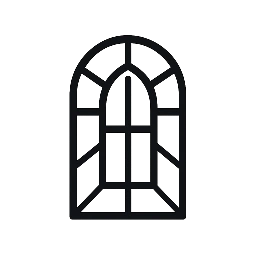Understanding the evolution of Christian art from its origins to the present day helps us understand our own church art. Below is a summary of the major artistic periods and their characteristics, as well as the key figures and artworks associated with them. Church art has evolved dramatically over two millennia, from clandestine symbols to monumental architectural and artistic masterpieces. Its history is a fascinating reflection of shifts in theology, societal structures, and artistic innovation.
Early Christian and Byzantine Art
In the Early Christian period (2nd-4th centuries), art was often symbolic and secretive due to Christian persecution. In the Roman Catacombs, for instance, art was subtle, using pagan motifs with new meaning, such as the peacock symbolizing immortality or the “Good Shepherd” representing Christ. Following the Edict of Milan in 313 AD, which legalized Christianity, art moved into the public sphere with the construction of basilicas and large-scale mosaics. The focus remained on conveying Christian narratives and key theological concepts to a largely illiterate populace.
The art of the Byzantine Empire (c. 330–1453) became highly formalized and spiritual, moving away from classical naturalism. Characterized by the use of gold, flat two-dimensional figures, and a focus on divine, otherworldly beauty, Byzantine art sought to be a “window into heaven.” Key forms included mosaics decorating church interiors, which depicted Christ Pantocrator (Christ the Almighty) and the Virgin Mary (Theotokos), and icons, which were seen as sacred portals for prayer and worship. The strict conventions of Byzantine iconography were designed to emphasize the timeless, unchanging nature of the divine.
Romanesque and Gothic Art
The Romanesque period (c. 1000–1200) saw the construction of massive stone churches that reflected a sense of solidity and strength. The art within these churches, often in the form of frescoes, sculpture, and illuminated manuscripts, was highly didactic, designed to teach biblical stories. Figures were simplified and often elongated, and compositions were flattened to emphasize their spiritual message over realistic depiction. Relief sculptures on sarcophagi and other objects also became popular.
The Gothic period (c. 12th-15th centuries) brought a dramatic shift in both architecture and art. The development of the pointed arch and the flying buttress allowed for taller, more delicate structures with vast stained-glass windows. This new architectural style, often called a “Sermon in Stone,” filled churches with light, a powerful symbol of the divine. Stained glass was a major art form, narrating biblical stories in vibrant color. Sculpture became more naturalistic, with figures showing emotion and movement. Key examples include the elaborate sculptural programs on the facades of cathedrals like Notre Dame and Chartres, which served as encyclopedias of faith for the faithful.
Renaissance and Baroque Art
The Renaissance (c. 14th-17th centuries) marked a return to the classical ideals of humanism, naturalism, and rational order. Religious art of this era, while still commissioned by the Church, emphasized the human and emotional aspects of biblical narratives. Artists like Leonardo da Vinci, Michelangelo, and Raphael created works of unprecedented realism and emotional depth. Leonardo’s Last Supper, Michelangelo’s Sistine Chapel ceiling, and Raphael’s Madonnas are prime examples of how artists blended theological themes with a newfound mastery of anatomy, perspective, and composition.
The Baroque period (c. 17th-18th centuries) emerged in part as a response to the Protestant Reformation and was a powerful expression of the Counter-Reformation. This style embraced drama, theatricality, and emotional intensity to inspire awe and devotion. Key characteristics include:
- Chiaroscuro, the dramatic use of light and shadow, seen in the paintings of Caravaggio.
- Emotional dynamism, as seen in the ecstatic sculptures of Gian Lorenzo Bernini, such as The Ecstasy of Saint Teresa.
- The fusion of art forms, where architecture, sculpture, and painting were combined to create immersive, spectacular environments.
Modern and Contemporary Art
In the 19th and 20th centuries, the relationship between art and the Church changed significantly. The rise of secularism, new artistic movements, and a decline in institutional patronage led to a divergence. While many artists moved away from religious themes, some, like Henri Matisse and Marc Chagall, continued to create important religious works, often in more abstract or symbolic styles.
Contemporary Christian art is incredibly diverse, reflecting a wide range of styles and media, from minimalist and abstract expressions to traditional realism. It often focuses on personal spiritual experience, social justice themes, and new ways of interpreting timeless biblical stories.
